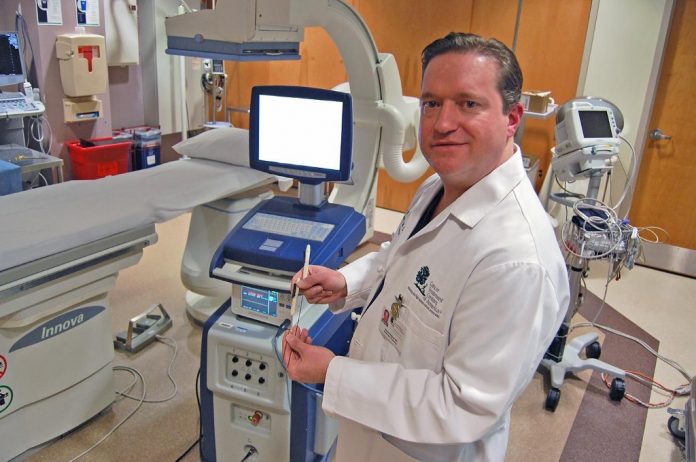New treatments: Since July 2012, Dr. Wagner has used the NanoKnife to perform procedures seven times. GREG BEZANIS / FOR THE TIMES
Back in August 2011, Peggy Reeder saw a doctor for a persistent cough.
Pneumonia was suspected. She had chest X-rays and blood work was taken.
Reeder, though, did not have pneumonia. She was diagnosed with pancreatic cancer.
Twenty-four chemotherapy treatments over a five-month period from October 2011 to March 2012 did not fully kill the tumor, and she didn’t want the cancer to spread.
Next, Dr. Steven C. Wagner of Cancer Treatment Centers of America told Reeder of the NanoKnife, a system that utilizes a minimally invasive method called irreversible electroporation to kill tumors in locations that are considered challenging or high risk. Philadelphia’s CTCA is the first hospital in Pennsylvania to use the NanoKnife.
Reeder, a 54-year-old from Myersville, Md., listened carefully, thought it over and eventually agreed to “get ’er done.” The procedure took place on Dec. 12 at CTCA’s Eastern Regional Medical Center at 1331 E. Wyoming Ave.
A scan taken after the procedure showed that the tumor was removed, and Reeder felt fine afterward.
“I wasn’t sore. I never got sick. I had no problems at all. I went on to a normal life,” she said. “Dr. Wagner did me right. I had faith in him. He’s the man.”
Reeder had the procedure on a Wednesday and was released two days later. Her friends, Doug and Shari Knott, who had been dating for 12 years, decided to get married on 12/12/2012. Their wedding reception was held two days later at a Mexican restaurant in Frederick, Md.
“I came home on Friday and went right to the wedding reception,” Reeder said.
Reeder has since joined Planet Fitness, spending her time there lifting weights and walking on the treadmill. She also swims for aerobic exercise.
The patient returned to CTCA for a follow-up scan on Jan. 18 and is scheduled to return for another one on March 15.
The three-month mark will be crucial, but the early results are promising.
“Peggy did great. Her treatment is done,” said Wagner, an interventional radiologist. “She was very nervous, but she’s done well. She’s a very sweet lady.”
CTCA is one of just a few dozen hospitals in the United States to offer the option.
“We’re so innovative and progressive in cancer care, and it’s yet another tool we have,” Wagner said.
Wagner spent a lot of time explaining the NanoKnife to Reeder and gave her time to decide whether the procedure was the right way to go.
In general, the treatment lasts two to five hours, and patients are given general anesthesia. They lie on their back or stomach.
Wagner carefully guides up to six thin needles/probes into the patient’s body and strategically places them around the tumor.
The NanoKnife includes a keyboard and screen that include the tumor size and the number of probes and energy level to be used. The probes, which are connected to cables hooked onto the machine, go through the skin and organ, then send electrical pulses to permanently puncture holes in the tumor, destroying it.
The doctor, who is passionate about his work, describes the NanoKnife treatment option as “exciting.” It is not only effective, but minimally invasive.
“She’s a great example,” he said of Reeder. “She had very little pain, if any. The probes are very, very thin. It’s a testament to how quickly a patient can recover.”
According to the National Cancer Institute, more than 45,000 Americans will be diagnosed with pancreatic cancer in 2013. Most will be age 65 and older.
A pancreatic cancer diagnosis often leaves few treatment options and little hope, since there are no early detection methods.
As for those who are diagnosed, Wagner believes the highly precise tumor-targeted therapy offered by the NanoKnife can be a lifesaver, killing the tumors without the need for surgery.
The device also may be used to treat tumors in or near the pancreas, liver, kidney, pelvis, gall bladder, bowel, major blood vessels and other areas. It spares surrounding healthy cell tissue and can be repeated, if necessary.
Typically, the tumors must be about 1¼ inches or smaller to proceed.
Wagner first saw the NanoKnife in 2010 at a conference of the Society of Interventional Radiology.
“My first impression was that it was too good to be true,” he said.
The cost was $400,000 — CTCA’s Illinois hospital also has one — and Wagner thinks the purchase has been worth it.
Since July 2012, Wagner has used the NanoKnife seven times. Three patients had pancreatic cancer, three had liver cancer and one had a lymph node on the abdomen.
Wagner acknowledges that there is no data to predict long-term outcomes, but believes the procedure to be a “safe and effective treatment.”
“We follow them closely after the procedure, and everyone so far has done well,” he said. “There are no wounds to recover from or incisions to heal. They can recover very quickly. Most patients are out the next day. It’s exciting for us. Patients have more options for treatment. It’s more individualized cancer care.”
The closest hospitals to CTCA that offer the NanoKnife, according to Wagner, are the University of Maryland Medical Center and the Memorial Sloan-Kettering Cancer Center in New York.
Wagner expects the device to become more popular in medical settings, noting that Philadelphia-area doctors often ask him a question.
“How’s that NanoKnife going?”••
Reporter Tom Waring can be reached at 215–354–3034 or [email protected]





